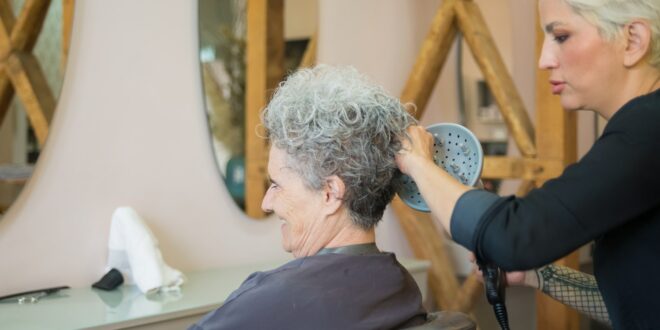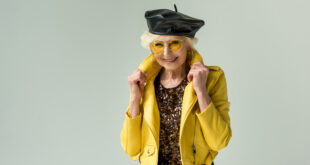Welcome back to Hair Care for Seniors, where we chat to a professional stylist about managing hair as we age. In this second part of our series, we’ll cover colour, style, and how to help your significant other with their hair. Plus, we bring you some seriously useful tips that are so easy, you’ll wonder why you never thought of them yourself!
Creative with colour
Just when you thought ‘going grey’ would make hair care easier, we have news for you: colour, and the use of foils, in particular, actually makes hair behave better! In fact, if you’re wanting to ‘go grey,’ prepare to invest in quality shampoos and conditioners to keep your mane under control.
The benefit of colour is it chemically ‘breaks down’ the structure of your hair, making it easier to set and style. However, the colouring process also dries out your hair, necessitating the use of specially designed ‘product’ to keep it looking good. So don’t feel your stylist is simply trying to make a sale when they introduce you to product. Listen carefully, make your selection, and learn how to use what you’ve purchased.
As for what colour to choose, it’s strictly personal, although it’s usually considered better to go lighter rather than darker as we age. If you do decide to go ‘darker,’ be aware your colour appointments will need to be more frequent (every 6 weeks), and therefore there will be more overall expense involved.
Seniors and styles
Hair style becomes more important to our appearance as we grow older, and although any style you want is fine, your commitment to it needs to increase with the years. That’s because ‘older’ hair is less co-operative than younger hair, and ‘the cut,’ is just part of the equation. If you don’t have time on your side, or if your hair is naturally straight and grey, go for a shorter style (long – especially long grey hair – becomes lank and straggly if not pampered). When choosing a style requiring maintenance to look its best, expect your hairdresser to teach you how to manage the cut, before you leave the salon. Practise dressing your hair, daily, until you can do it in a rush – don’t leave it until you’re going out to try and perfect the look.
Creative couples
One of the difficulties of managing hair as we grow older, is styling it at home can be tiring, or (if you suffer from the likes of arthritis) downright impossible. That’s where a willing partner can come to the rescue, so don’t be afraid to take them along with you to the salon. Any hairdresser worth their salt will be willing to demonstrate to a partner how to use product and a blow drier to get your hair looking great. A lesson from a hairdresser is also invaluable for partners, or friends and family, caring for a loved one with dementia. We all want to look our best, regardless of circumstances.
Quick tips
- Can’t tell your shampoo from your conditioner once you’re in the shower without your glasses? Take a waterproof marker pen, and write a large ‘S’ and ‘C’ on the relevant containers.
- Learning to help a partner with their hairstyle? Take their product and your camera along to their hair appointment. Line up the product in the order in which it is to be used, and ‘snap’ the shot to help you remember. Remember to take a shot of the finished style before your partner leaves the salon, too. It will help you to style at home.
- Having trouble getting your hair to look its best at home? The problem is very likely to be your hairdryer isn’t powerful enough – time to upgrade!
- Is your hair thinning? While products can help, they can be a significant financial commitment. Colouring, however, can help create an optical illusion of a fuller head of hair.
- The more you lose colour in your hair, the more you need to put it on your face. Invest in some bright lipsticks and wear more colourful clothes!
- Can’t get to the salon before the regrowth appears? Ask your stylist about touch-up sprays.









Join the Discussion
Type out your comment here:
You must be logged in to post a comment.